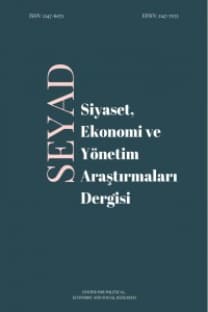Halloween Etkisinin İstanbul Menkul Kıymetler Borsasında Geçerliliğinin Testi
Bu çalışmada, Kasım-Nisan döneminde gerçekleşen hisse senedi getirilerinin Mayıs-Ekim döneminde gerçekleşen getirilere göre daha yüksek olduğunu ifade eden ve ilk kez Bouman ve Jacobsen 2002 tarafından incelenen Halloween etkisinin varlığı Ocak 1990-Aralık 2010 dönemi için İstanbul Menkul Kıymetler Borsası’nda İMKB en küçük kareler yönteminin yanı sıra aykırı değerlere karşı güçlü tahminciler veren Huber’in M-tahminci tekniğiyle araştırılmıştır. Elde edilen sonuçlar İMKB’de Halloween etkisinin olmadığını, Bouman ve Jacobsen 2002 tarafından İMKB’de bulunan etkinin esas sebebinin aykırı değerler olduğunu göstermektedir.
Anahtar Kelimeler:
Halloween Etkisi, Ocak Ayı Etkisi, Aykırı Değer, Etkin Piyasa
The Validity of the Halloween Effect in the Istanbul Stock Exchange
In this study, we analyze the validity of Halloween effect in Istanbul Stock Exchange ISE between January 1990 - December 2010 which implies stock returns are lower during the May-October period versus the November-April period. As well as the Least Squares Method, we use Huber’s M-estimator which is a robust estimator against to outliers, and conclude that there is no Halloween effect in the ISE which shows the finding of Bouman and Jacobsen 2002 is due to disregarding outliers
Keywords:
Halloween effect, January effect, outlier, market efficiency,
___
- Bachelier, Louis (1900), “Théorie de la spéculation”, Annales Scientifiques de l’École Normale Supérieure, 3(17), pp. 21-86. (Bu tez aynı sene içerisinde Gauthier-Villars (70 sayfa) yayınevinde kitap olarak da basılmıştır), http://goo.gl/7cwLW, 21.10.2012.
- Balaban, Ercan (1995), “January Effect, Yes What about Mark Twain Effect?”, The Central Bank of the Republic of Turkey, Research Department, Discussion Paper No: 9509.
- Bouman, Sven and Ben JACOBSEN (2002), “The Halloween Indicator, ‘Sell in May and Go Away’: Another Puzzle”, American Economic Review, 92(5), p. 1618-35.
- Cao, Melanie and Jason WEI (2005), “Stock Market Returns: A Note on Temperature Anomaly”, Journal of Banking and Finance, 29(6), p. 1559-1573.
- Courtault, Jean-Michel, Youri Kabanov, Bernard Bru, Pierre Crepel, Isabelle Lebon and Arnaud Le Marchand (2000), “Louis Bacheleier on the Centenary of Théorie de la spéculation”, Mathematical Finance, 10(3), p. 341–353.
- Depresyon ve Panik Atak Merkezi, http://www.depam.com, 06.09.2012.
- Doeswijk, Ronald (2008), “The Optimism Cycle: Sell in May”, De Economist, 156(2), p. 175-200.
- Dimson, Elroy and Massoud Mussavian (2000), “Market Efficiency”, The Current State of Business Disciplines, 3, p. 959-970.
- Huber, Peter J. (1964), “Robust Estimation of a Location Parameter, Annals of Mathematical Statistics, 35, p. 73−101.
- Iglewicz, Boris and David Hoaglin (1993), How to Detect and Handle Outliers, ASQC Quality Press.
- Kamstra, Mark J., Lisa A. Kramer and Maurice D. Levi (2003), “Winter Blues: A SAD Stock Market Cycle”, American Economic Review, 93, p. 324-343.
- Lucey, Brian M. and Shelly Zhao (2008), “Halloween or January? Yet another puzzle”, International Review of Financial Analysis, 17(5), p. 1055-1069.
- Maberly, Edwin Darrell and Raylene M. Pierce (2003), “The Halloween Effect and Japanese Equity Prices: Myth or Exploitable Anomaly”, Asia-Pacific Financial Markets, 10(4), p. 319–334.
- Maberly, Edwin Darrell and Raylene M. Pierce (2004), “Stock Market Efficiency Withstands another Challenge: Solving the ‘Sell in May / Buy after Halloween’ Puzzle”, Econ Journal Watch, 1, p. 29–46.
- Marquering, Wessel (2002), “Seasonal Predictability of Stock Market Returns”, Review of Business and Economics, 47(4), s. 557-576
- Newey, Whitney K. and Kenneth D. West (1987), “A Simple, Positive Semi- definite, Covariance Matrix”, Econometrica, 55(3), p. 703-708. and
- Autocorrelation Consistent
- Siriopoulos, Costas and Panagiotis Giannopoulos (2006), “Market Efficiency in the Greek Stock Exchange: The Halloween Effect”, Spoudai, 56(2), p. 75-88.
- Twain, Mark (1894), The Tragedy of Pudd’nhead Wilson, The American Publishing Company, Hartford CT, http://goo.gl/7XX6c, 25.09.2012.
- Witte, H. Douglas (2010), “Outliers and the Halloween Effect: Comment on Maberly and Pierce”, Econ Journal Watch, 7(1), p. 91-98.
- Zarour, Bashar A. (2007), “The Halloween Effect Anomaly: Evidence from Some Arab Countries Equity Markets”, Studies of Business and Economics, 13(1), p. 68-76.
- ISSN: 2147-6071
- Yayın Aralığı: Yılda 2 Sayı
- Başlangıç: 2014
- Yayıncı: Politik Ekonomik ve Sosyal Araştırmalar Merkezi
Sayıdaki Diğer Makaleler
Enflasyonun Tarımsal Fiyatlar Üzerindeki Etkileri: Panel Yumuşak Geçiş Regresyon Analizi
Bülent GÜLOĞLU, Şaban NAZLİOGLU
Türkiye’de Elektrik Tüketiminin Ekonomik Gelişmeye Etkisi: Coğrafi Ağırlıklı Regresyon Yöntemi
Tuğba ASLAN, Ayşe ARI, Fatma ZEREN
Ekonomik Büyümenin Belirleyicileri: Sınır Testi Yaklaşımı
Halloween Etkisinin İstanbul Menkul Kıymetler Borsasında Geçerliliğinin Testi
